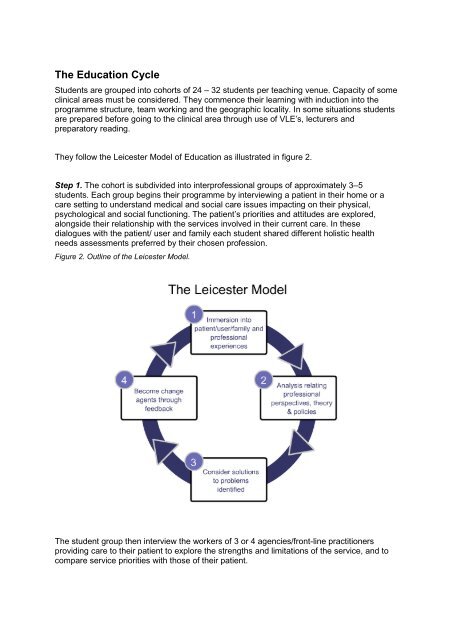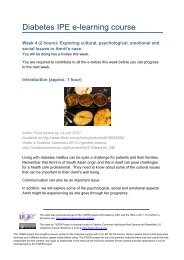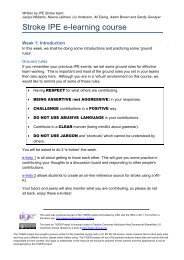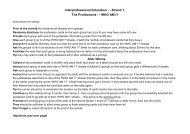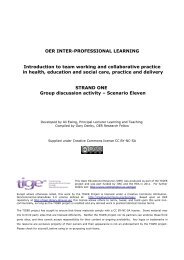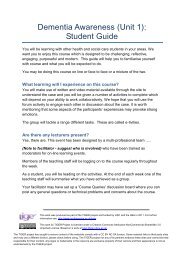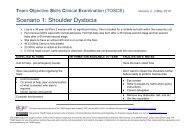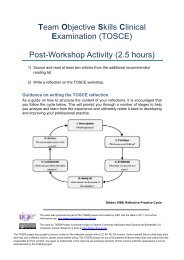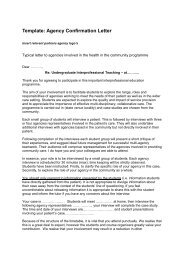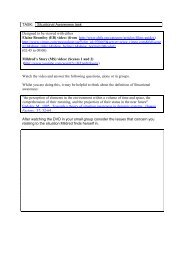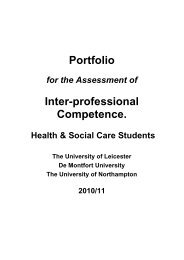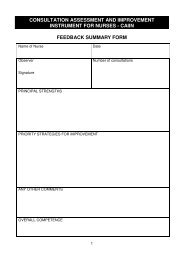2 The Education Cycle.pdf - TIGER Home
2 The Education Cycle.pdf - TIGER Home
2 The Education Cycle.pdf - TIGER Home
You also want an ePaper? Increase the reach of your titles
YUMPU automatically turns print PDFs into web optimized ePapers that Google loves.
<strong>The</strong> <strong>Education</strong> <strong>Cycle</strong><br />
Students are grouped into cohorts of 24 – 32 students per teaching venue. Capacity of some<br />
clinical areas must be considered. <strong>The</strong>y commence their learning with induction into the<br />
programme structure, team working and the geographic locality. In some situations students<br />
are prepared before going to the clinical area through use of VLE’s, lecturers and<br />
preparatory reading.<br />
<strong>The</strong>y follow the Leicester Model of <strong>Education</strong> as illustrated in figure 2.<br />
Step 1. <strong>The</strong> cohort is subdivided into interprofessional groups of approximately 3–5<br />
students. Each group begins their programme by interviewing a patient in their home or a<br />
care setting to understand medical and social care issues impacting on their physical,<br />
psychological and social functioning. <strong>The</strong> patient’s priorities and attitudes are explored,<br />
alongside their relationship with the services involved in their current care. In these<br />
dialogues with the patient/ user and family each student shared different holistic health<br />
needs assessments preferred by their chosen profession.<br />
Figure 2. Outline of the Leicester Model.<br />
<strong>The</strong> student group then interview the workers of 3 or 4 agencies/front-line practitioners<br />
providing care to their patient to explore the strengths and limitations of the service, and to<br />
compare service priorities with those of their patient.
Students additionally meet with representatives of the community in which their patient lives,<br />
to gain a wider understanding of the context of service provision e.g. the police or tenants’<br />
association or with managers from NHS Trusts.<br />
Step 2. Facilitated by experienced clinical and academic tutors, the student group reflects on<br />
each interview. <strong>The</strong>y relate service and theoretical perspectives with health and social care<br />
policies; they then interpret their findings and prioritise the issues identified. This process is<br />
supported by a range of experts which reflect the learning outcomes e.g. disability trainers,<br />
occupational psychologists.<br />
Step 3. Following the interviews the student group analyse the interdependence of different<br />
statutory and voluntary providers and critique their team working. <strong>The</strong>y then identify practical<br />
multi-agency solutions to improve the patient’s quality of service delivery.<br />
Step 4. <strong>The</strong> education cycle is completed with student solutions formally presented to the<br />
agency workers and their managers in an interactive presentation session. Students also<br />
provide written feedback to the individual service providers.<br />
In clinical wards students combine care for these patients with working together to achieve<br />
the outcomes of the Model of learning.<br />
Distinctive Features of the Leicester Model<br />
• students are placed at the centre of service delivery, developing skills to provide multidisciplinary<br />
care, learning directly from patients and their service providers;<br />
• patients are partners in delivering and shaping the programme;<br />
• the learning cycle has the potential to change and improve current practice;<br />
• students gain insights into competing service priorities, communication issues, cultural<br />
and language barriers, and its impact on service delivery;<br />
• students learn with colleagues across health and social care settings in<br />
interprofessional or uniprofessional groups and across community and hospital based<br />
care, with learning underpinned by theoretical perspectives;<br />
• the education method is reflective, experiential and problem solving which encourages<br />
active learning and critical enquiry;<br />
• formal presentations transform students into active partners in the development of<br />
multi-agency service delivery;<br />
• service providers and managers can reflect on their case with their colleagues from the<br />
statutory and voluntary sectors and across the community-hospital interface;<br />
• students learn from patient groups which are known to encounter inequitable access to<br />
healthcare, e.g. disabled people and the socio-economically disadvantaged;<br />
• the model facilitates partnership working between Higher <strong>Education</strong> Institutions and<br />
organisations delivering care to the public. Academic tutors are immersed in an<br />
environment which both experiences and debates current clinical practice. Front line<br />
service providers are given opportunities to develop their educational skills as tutors.<br />
<strong>The</strong>oretical <strong>Education</strong> Perspectives<br />
<strong>The</strong> Leicester Model seeks to enable students to be motivated to learn, to be inquisitive in<br />
their search for explanations and to apply their knowledge in a problem solving 1 manner to<br />
gain new understanding. <strong>The</strong> Leicester Model, including its interprofessional learning<br />
1 Knowles, M. (1984). Andragogy in Action, Gulf Publishing Co, Houston.
opportunities, is grounded in adult learning theory 2 and aims to promote deep thinking rather<br />
than learning by rote, and encourage students to apply knowledge to a range of situations<br />
and interpret their findings in the context of new situations. This goal is underpinned by<br />
constructivism theories 3 and its components of experiential learning 4 and reflection 5 .<br />
<strong>The</strong>re is evidence that deep approaches to learning are more likely to be associated with<br />
6<br />
higher quality learning outcomes . <strong>The</strong>se are achieved in the Leicester Model by:<br />
7<br />
• aligning programme outcomes with the overall curriculum content ;<br />
• the programme methodology of tutor facilitated, small-group activities, where students<br />
can learn from their experiences and formulate recommendations;<br />
• assessments that support the aims and outcomes by constructive alignment 8 ;<br />
• the rigorous, on-going programme of tutor preparation for the teaching method;<br />
• partnership working between HEIs and health and social care organisations;<br />
• the creation of non-threatening, protected learning environments.<br />
Interprofessional Perspectives<br />
<strong>The</strong> Leicester Model delivers quality interprofessional learning which achieves the standards<br />
set by the UK Centre for the Advancement of Interprofessional <strong>Education</strong> (CAIPE) 9 , through<br />
the small interactive group learning that:<br />
• enables students to personally experience, analyse and reflect on interprofessional<br />
working in their groups as well as observe others;<br />
• is patient-centred from real-life experiences;<br />
• allows students to explore professional roles and responsibilities in patient care;<br />
• acknowledges that different professions work from different perspectives;<br />
• allows similarities and differences between professionals to be respected;<br />
• is appreciative of each others professional training and roles in the workplace;<br />
• acknowledges terminology and language used by professions;<br />
• ensures a greater understanding of why collaboration improves quality of patient care;<br />
• engages students in the learning partnerships, making a full and positive contribution.<br />
Learning Objectives<br />
<strong>The</strong> Leicester Model flexibly delivers a range of educational objectives and learning<br />
outcomes, and at different academic levels, to develop:<br />
• knowledge, skills and attitudes of team working within and across organisational<br />
boundaries;<br />
• a practical understanding of interprofessional service delivery;<br />
• clinical and interpersonal skills;<br />
• an appreciation of the patient at the centre of service delivery;<br />
2 Bruner, J.S. (1960). <strong>The</strong> Process of <strong>Education</strong>, Harvard University Press, Cambridge, Massachusetts.<br />
3 Piaget, J. (1950). <strong>The</strong> Psychology of Intelligence, Routledge and Kegan Paul, London.<br />
4 Kolb, D.A. (1984). Experiential Learning, Prentice-Hall, Englewood Cliffs, New Jersey.<br />
5 Shön, D. (1987). Educating the reflective practitioner. San Francisco: Jossey-Bass Publishers.<br />
6 Prosser, M. and Trigwell K. (1999). Understanding Learning and Teaching: <strong>The</strong> experience in Higher <strong>Education</strong>,<br />
Buckingham, SRHE/Open University Press.<br />
7 Biggs, J.B. (1987). Student Approaches to Learning and Studying, Australian Council for <strong>Education</strong> Research, Melbourne.<br />
8 Biggs, J.B. (1996). Enhancing teaching through constructive alignment, Higher <strong>Education</strong>;32:1-18.<br />
9 <strong>The</strong> UK Centre for the Advancement of Interprofessional <strong>Education</strong> (www.caipe.org.uk)
• an understanding of the specific needs of marginalised sectors of the population<br />
whose access to health and social care is problematic.<br />
• An understanding of specific issues faced by in-patients in respect to their clinical<br />
problem and stage of the life cycle.<br />
Learning outcomes can be applied across the learning continuum from pre to post<br />
registration and for professional and non-professional groups. <strong>The</strong> model allows flexible<br />
application of outcomes that are both challenging and reflecting the cognitive level of<br />
learning. Evaluation studies, both internal and external 10,11 ,<br />
confirm that the learning<br />
outcomes are achieved.<br />
Assessment<br />
All programme assessments are aligned with the learning outcomes and the educational<br />
methodology. <strong>The</strong>y are generally multi-method, with many programmes having a common<br />
assessment of a case study report. This report requires the student to critically analyse the<br />
information obtained from the range of interviews and visits in order to develop ideal<br />
solutions to improve the care provided to the individual patient and that of the healthcare<br />
systems in which the patient is placed. <strong>The</strong> use of multi-method approaches minimises the<br />
disadvantage that some professionals may experience when working within a multidisciplinary<br />
group.<br />
• all pre-registration interprofessional learning is recorded in a case study;<br />
• for post-qualified students, assessments include a reflective component based on the<br />
learner’s clinical experiences;<br />
• master-level assessments include case studies, reflective portfolios and in some cases<br />
competency based problem-solving papers which test the application of the learner’s<br />
knowledge to clinical practice.<br />
<strong>Education</strong> Potential<br />
Interprofessional working to achieve collaborative practice can be realised through this<br />
model of education. It can engage with a wide range of professional and non-qualified staff<br />
for example health and social care clinical and management staff, therapists, psychologists,<br />
pharmacists, healthcare support workers and a range of non-health organisations who work<br />
impacts on healthcare (e.g. housing officers).<br />
<strong>The</strong>re is a great potential for expanding this approach to learning. <strong>The</strong> model has already<br />
been replicated across urban and rural locations and in hospital and social care settings,<br />
using a range of clinical diseases and socio-economic environments.<br />
Evaluation<br />
All programmes undergo robust, quality audit cycles using a variety of methods, involving<br />
programme stakeholders and students.<br />
10 Lennox, A., Petersen S. (1998). Development and evaluation of a community based, multi-agency course for medical<br />
students: descriptive study. British Medical Journal;316: 596-9.<br />
11 NHS Executive Report on Third Year, G Wykurz. Shaping Your Future Medical Workforce: Developing the NHS Role in<br />
Planning Undergraduate Medical Curricula.


